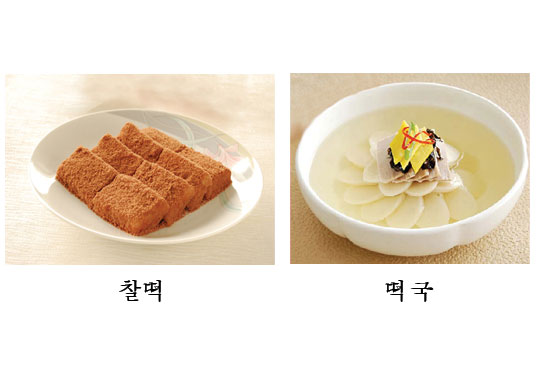Typical festive dishes for the lunar New Year’s Day
The festive dishes for the lunar New Year’s Day are of distinctive features according to the localities, but typical are jolphyon (fancy rice cake), chalttok (glutinous rice cake), solkittok (steamed rice cake), ttokkuk (rice-cake soup), mung-bean pancake, roast meat, kangjong (fried glutinous rice cake), yakkwa (cake made from wheat flour, oil and honey), sujongkwa (fruit punch made of honey), liquors, fruit and so on.
Among the rice cakes, jolphyon (fancy rice cake) which is not dressed is mostly enjoyed on the day.
As for chalttok (glutinous rice cake), since early times, our people made it by pounding steamed glutinous rice on the flat stone with mallets. Pounding with all strength makes the dough sticky and tasty. Then, the dough is cut into pieces and the pieces are dressed with adzuki beans, sesame, jujubes, chestnuts, pine nuts and kidney beans.
Solkittok (steamed rice cake) is made by kneading rice flour with hot water into half cooked dough and being steamed in several layers of the dough and dressings.
Rice, glutinous rice, millet, sorghum are main materials of solkittok, and adzuki bean, soybeans, sesame, mung beans are used for its dressing.
Ttokkuk (rice-cake soup) is the most symbolic food among those for the lunar New Year’s Day.
Slices of bar rice cake are put in boiling soup flavored with soy sauce. After a while, fried chicken or pheasant is added, and ground pepper is sprinkled.
It is told that every bowl of rice-cake soup means a year to one’s age.
Mung-bean pancake of strong national taste, one of the three representative foods of Korea along with kimchi and pulkogi (barbecue), is well known to the world.
Mung-bean pancake of Pyongyang area is peculiar, for it is fried with a thin slice of fat or sliced kimchi in the center.
One of the conspicuous dishes for this day is roast meat. Particularly, grilled beef and roast pheasant are famous since early times.
The recipe of the grilled beef characterized by that it is seasoned with various spices is unique to Korea. Appropriate fire control is needed so that its outside is well roasted and but inside half roasted.
For the roast pheasant, first, pheasants are singed and plucked. And the pectoral flesh is cut into two or three pieces, while the legs are skinned. Secondly, the pectoral pieces and skinned legs are seasoned with minced garlic, sesame, oil, pepper, honey and salt. Finally, they are wrapped up in wet paper and roasted.
Kangjong (fried glutinous rice cake) is a native confectionery that should not be missed on the lunar New Year’s Day. For that, glutinous rice flour is kneaded with liquor and fermented some time. Then the fermented dough is cut into pieces of a certain form and dried. Finally, the dried pieces are fried in oil, spread with corn syrup or honey and dressed with fried rice on the surface. Kangjong is also called sanja.
In order to make yakkwa (cake made from wheat flour, oil and honey) wheat flour is kneaded with honey, oil, liquor and ginger sap. The dough is stamped out with a die or cut into pieces of an appropriate size. Just after frying in oil, they should be put in honey and coated with the ground pine nut and cinnamon.
On the lunar New Year’s Days grandparents used to give yakkwa and kangjong to young boys and girls who made the New Year’s calls.
Sujongkwa (fruit punch made of honey) is a drink that our people used to drink on the day. Dried persimmons are first put in water to be swollen and again in the ginger decocted water with honey and pine nuts.
Among the liquors on the day, tosoju was the first. As medicinal liquor, it was brewed with various medicinal herbs including cinnamon, Xanthoxylum piperitum, Atractylodes japonica, balloon flower, Umbelliferae and the like. As a proverb said that liquor on the lunar New Year’s Day should not be warm, people drank little cold liquor on the day. This drinking custom reflected our people’s desire not to lose their health while enjoying holiday, and to lead a diligent life with fresh mind from the first day of the year.
